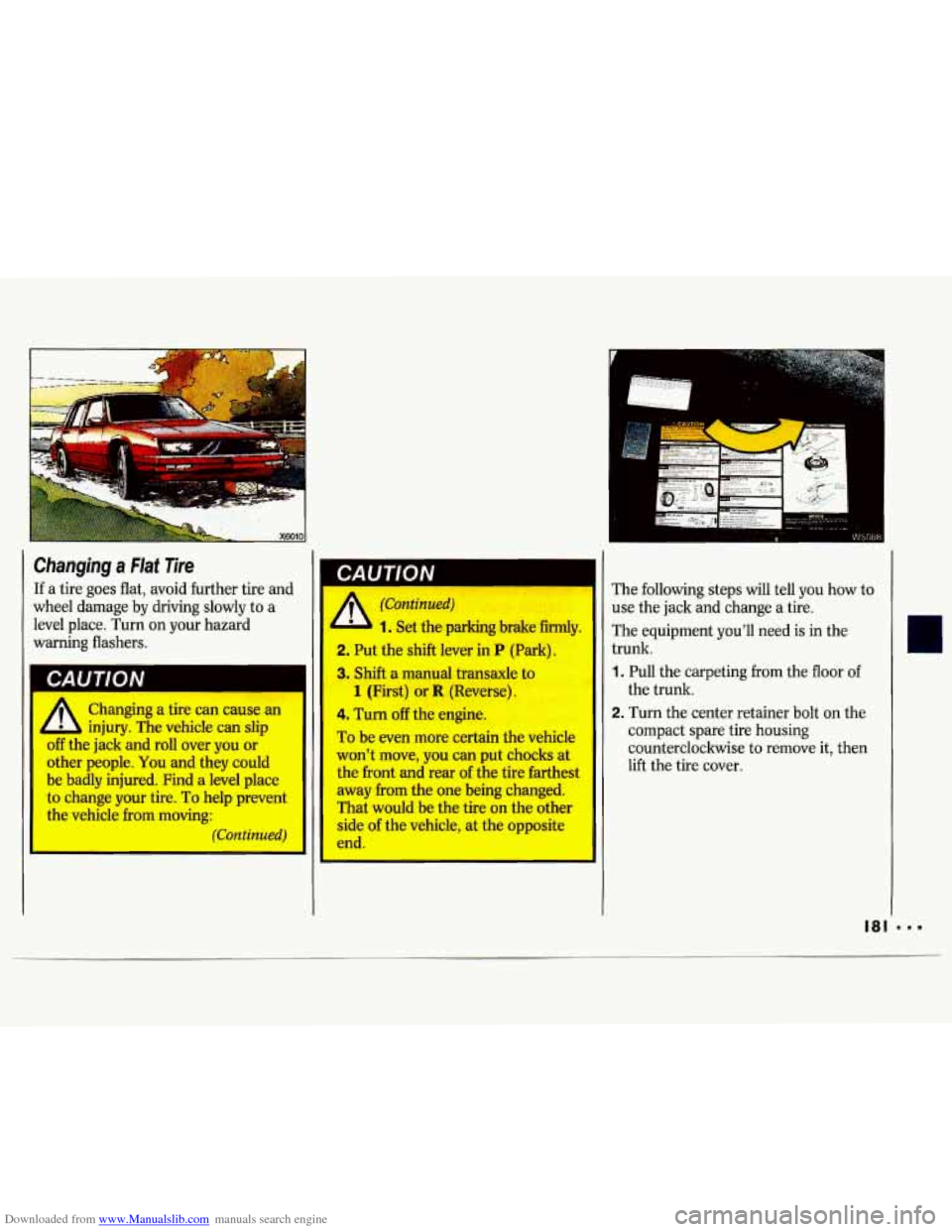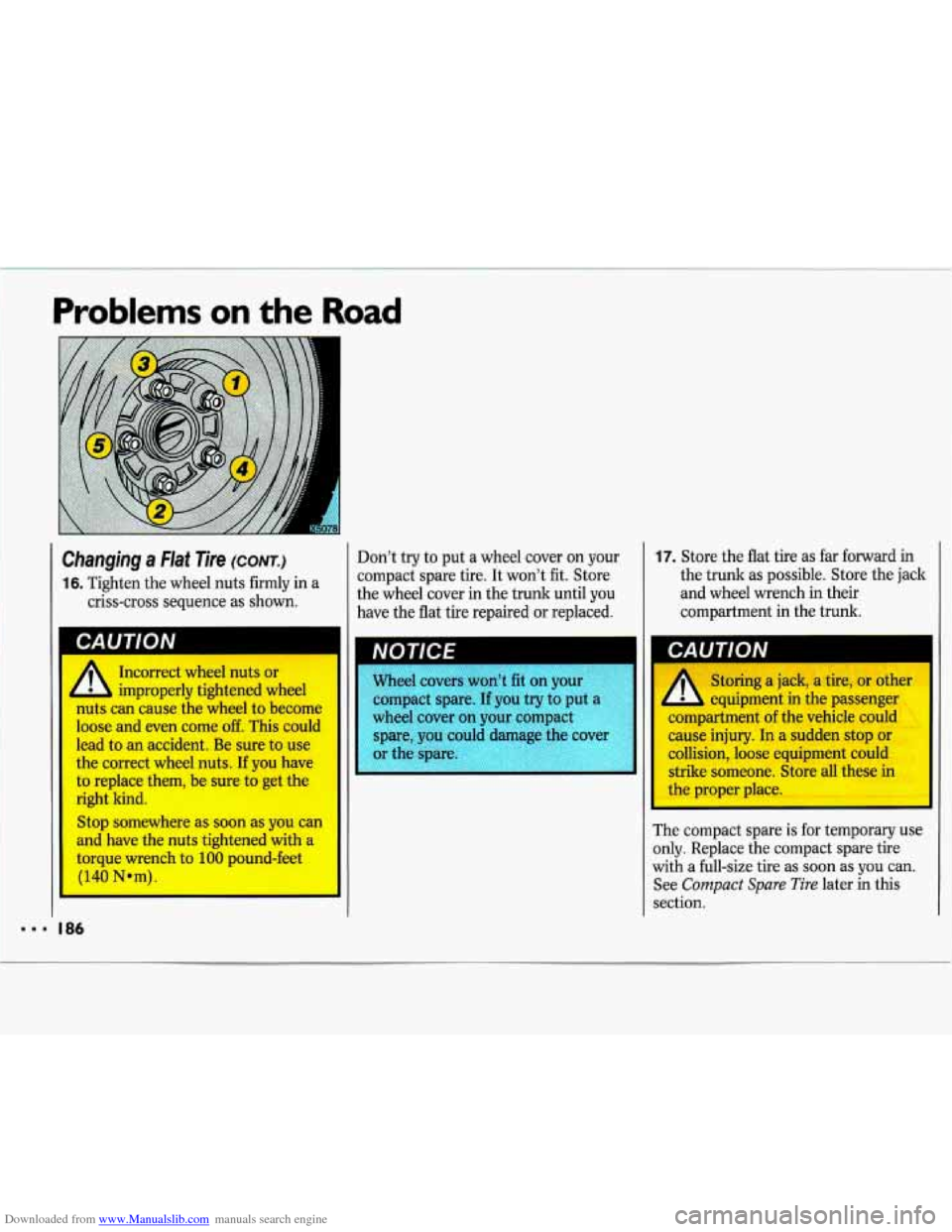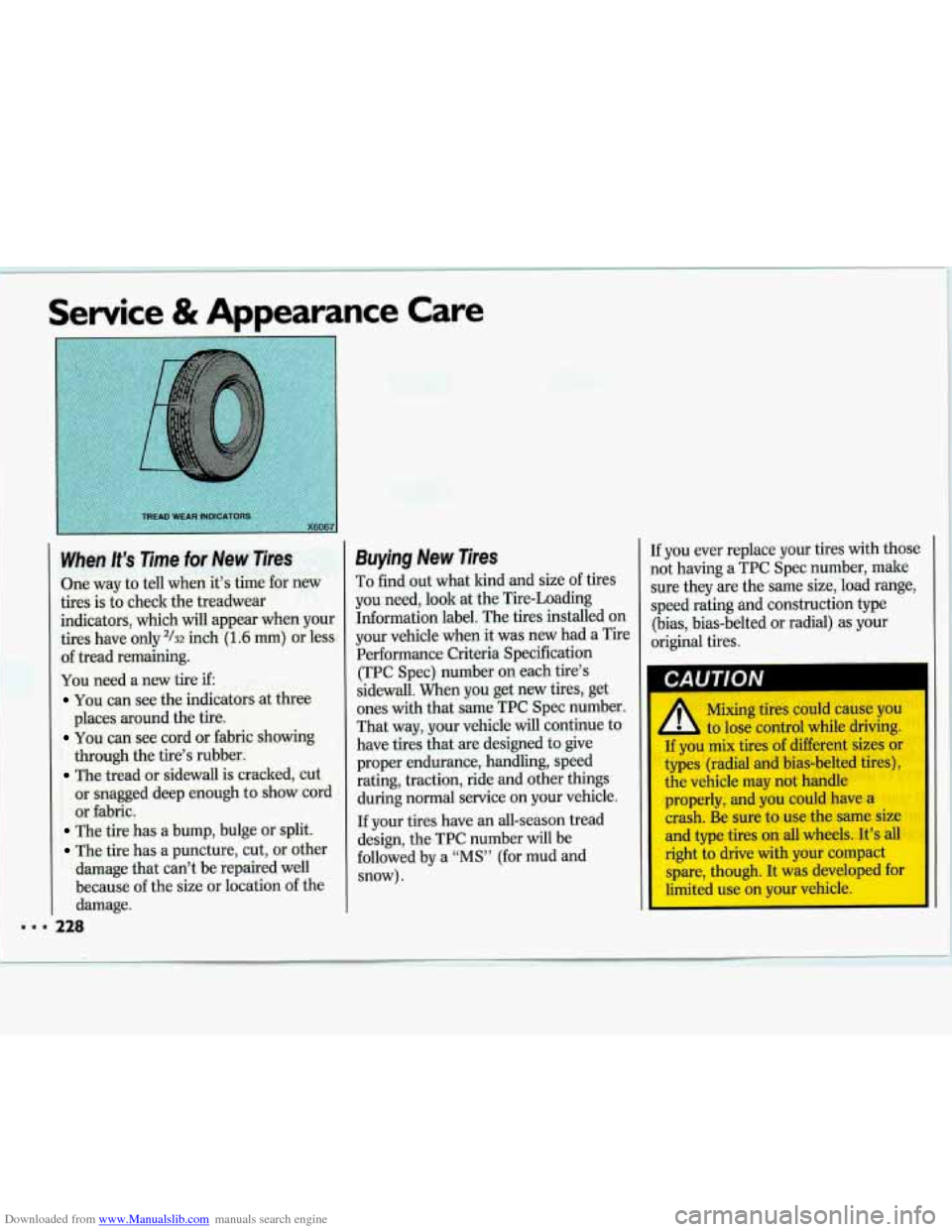Page 183 of 324

Downloaded from www.Manualslib.com manuals search engine n
Changing a FIaf Tire
If a tire goes flat, avoid further tire and
wheel damage by driving slowly to
a
level place. Turn on your hazard
warning flashers.
I
CAUTION I
A
Changing a tire can cause an
injury. The vehicle can slip
off the jack and roll over you or
other people.
You and they could
be badly injured. Find a level place
to change your tire. To help prevent
the vehicle from moving:
(Continued)
(Continued)
f 1. Set the parking brake firmly.
2. Put the shift lever in P (Park).
3. Shift a manual transaxle to
1 (First) or R (Reverse).
4. Turn off the engine.
To be even more certain the vehicle
won't move, you can put chocks at
the front and rear
of the tire farthest
away from the one being changed.
That would be the tire on the other
side
of the vehicle, at the opposite
end. The following steps will tell
you how
to
use the jack and change a tire.
The equipment you'll need is in the
trunk.
1. Pull the carpeting from the floor of
the trunk.
2. Turn the center retainer bolt on the
compact spare tire housing
countercloclnvise to remove it, then
lift the tire cover.
r
Page 184 of 324
Downloaded from www.Manualslib.com manuals search engine Problems on the Road
Changing a Flat Tire (CONT.)
3. Turn the wheel wrench retainer nut
located under the tire cover
counterclockwise to remove the
wheel wrench. 4. Remove the wing nut securing the
compact spare tire and spacer by
turning it counterclockwise. Then lift
off the spacer and remove the spare
tire.
5. Remove the bolt securing the jack by
turning it countercloclnvise. Then
remove the jack.
6. If there is a wheel cover, remove it by
using the flat end
of the wheel
wrench.
Pry along the edge of the
wheel cover until it comes
off. Be
careful; the rim edges may be sharp.
Don’t
try to remove it with your bare
hands.
Page 186 of 324
Downloaded from www.Manualslib.com manuals search engine Pro"'3ms on the Road
Changing a Flat Tire (CONT.)
10. Position the jack and raise the jack
head until it fits firmly into the
notch in the vehicle's frame nearest
the flat tire. Put the compact spare
tire near you.
Getting under a vehicle whc-
L b it is jacked up is dangerous.
If the vehicle slips
off the jack, you
could be badly injured
or killed.
Never get under a vehicle when it
is
supported only by a jack. I
11. Raise the vehicle by rotating the
wheel wrench clockwise. Raise the
vehicle far enough
off the ground so
there is enough room for the spare
tire to fit.
off the flat tire.
12. Remove all the wheel nuts and take
king your vehicle with the jack
improperly positioned will damage
L
Page 187 of 324
Downloaded from www.Manualslib.com manuals search engine CAUTION
13. Remove any rust or dirt from the 14. Replace the wheel nuts with the
wheel bolts, mounting surfaces or rounded end of the nuts toward the
spare wheel. Place the spare on the
wheel. Tighten each nut by
hand
wheel mounting surface.
until the wheel is held against the
I hub.
t
I
Never use oil or grease on
studs
or nuts. If you do, the
nuts might come loose. Your wheel
could fall
off, causing a serious
accident.
15. Lower the vehicle by rotating the
wheel wrench countercloclnvise.
Lower the jack completely.
Page 188 of 324

Downloaded from www.Manualslib.com manuals search engine Problems on the Road
Changing a Flat Tire (CONT.)
16. Tighten the wheel nuts firmly in a
criss-cross sequence as shown.
...
I
CAUTION
Incorrect wheel nuts or
rluLs can cause the wheel to become
loose and even come
off. This could
lead to an accident. Be sure to use
the correct wheel nuts.
If you have
to replace them, be sure to get the
right kind.
Stop somewhere as soon as you can
and have the nuts tightened with a
torque wrench to
100 pound-feet
(140 Nom).
c improperly tightened wheel
86
Don't try to put a wheel cover on your
compact spare tire. It won't fit. Store
the wheel cover in the trunk until you
have the flat tire repaired or replaced.
Wheel covers won't fit on your
compact spare.
If you try to pu
wheel cover on your compact
spare, you could damage the co"
I
17. Store the flat tire as far forward in
the trunk as possible. Store the jack
and wheel wrench in their
compartment in the trunk.
Storing a jack, a tire, or other
- equipment in the passenger
compartment of the vehicle could
cause injury. In a sudden stop or
collision, loose equipment could strike someone. Store all these in
the proper place.
The compact spare
is for temporary use
only. Replace the compact spare tire
with a full-size tire as soon as
you can.
See
Compact Spare Tire later in this
section.
Page 189 of 324
Downloaded from www.Manualslib.com manuals search engine Compact Spare Tire
Although the compact spare was fully
inflated when your vehicle was new, it
can lose air after a time. Check the
inflation pressure regularly. It should be
60 psi (420 kPa). The compact spare is
made to go up to
3,000 miles
(5 000 Inn), so you can finish your trip
and have
your full-size tire repaired or
replaced where
you want. Of course, it’s
best to replace your spare with a full-
size tire as soon as you can. Your spare
will last longer and be in good shape in
case you need it again. Your anti-lock
brake system warning light may come
on when you are driving with a compact
spare. See the
Index under Anti-Lock
Brake System Warning Light.
Don’t use your compact spare on some
other vehicle.
And don’t
mix your compact spare or
wheel with other wheels or tires. They
won’t fit. Keep your spare and its wheel
together.
Page 229 of 324

Downloaded from www.Manualslib.com manuals search engine When to Check:
Check your tires once a month or more.
Don't forget your compact spare tire. It
should be at
60 psi (420 kPa).
How to Check
Use a good quality pocket-type gage to
check tire pressure. Simply looking
at
the tires will not tell you the pressure,
especially
if you have radial tires-
which may look properly inflated even
if
they're underinflated.
If your tires have valve caps, be sure to
put them back on. They help prevent
leaks by keeping out dirt and moisture.
Tire Inspection and Rotation
To make your tires last longer, have
them inspected and rotated at the
mileages recommended in the
Maintenance Schedule. See the
Index
under Scheduled Maintenance
Services.
Use this rotation pattern.
Mer the tires have been rotated, adjust
the front and rear inflation pressure as
shown on the Tire-Loading Information
label. Make certain that
all wheel nuts
are properly tightened. See the
Index
under Wheel Nut Torque.
I
Rust or dirt on a wheel, or on
the parts to which it is
fastened, can make the wheel nuts
become loose after
a time. The
wheel could come
off and cause an
accident. When you change a
wheel, remove any rust
or dirt from
places where the wheel attaches to
the vehicle. In an emergency, you
can use a cloth
or a paper towel to
do this; but be sure to use a scraper
or wire brush later,
if you need to,
to get all the rust or dirt off. (See
the
Index under Changing a Flat
Tire.)
L
Page 230 of 324

Downloaded from www.Manualslib.com manuals search engine Servi - - & f -- MI -- 3arance Care
When It’s Time for New Tires
One way to tell when it’s time for new
tires is to check the treadwear
indicators, which will appear when your
tires have only
2/32 inch (1.6 mm) or less
of tread remaining.
You need a new tire if:
You can see the indicators at three
You can see cord or fabric showing
The tread or sidewall is cracked, cut
places around
the tire.
through the tire’s rubber.
or snagged deep enough to show cord
or fabric.
The tire has a bump, bulge or split.
The tire has a puncture, cut, or other
damage that can’t be repaired well
because of the size or location of the
damage.
Buying New Tires
To find out what kind and size of tires
you need, look at the Tire-Loading
Information label. The tires installed on
your vehicle when it was new had a Tire
Performance Criteria Specification
(TPC Spec) number on each tire’s
sidewall. When you get new tires, get
ones with that same TPC Spec number.
That way, your vehicle will continue to
have tires that are designed to give
proper endurance, handling, speed
rating, traction, ride and other things
during normal service on your vehicle.
If your tires have an all-season tread
design, the TPC number will be
followed by a
“MS” (for mud and
snow). If
you ever replace your tires with those
not having a TPC Spec number, make sure they are the same size, load range,
speed rating and construction type (bias, bias-belted or radial) as your
original tires.
I CAUTION I
Mixing tires could cause you
to lose control while driving.
If you mix tires of different sizes or
types (radial and bias-belted tires)
,
the vehicle may not handle
properly, and you could have a crash. Be sure to use the same size
and type tires on all wheels. It’s all
right to drive with your compact
spare, though. It was developed for
limited use
on your vehicle.